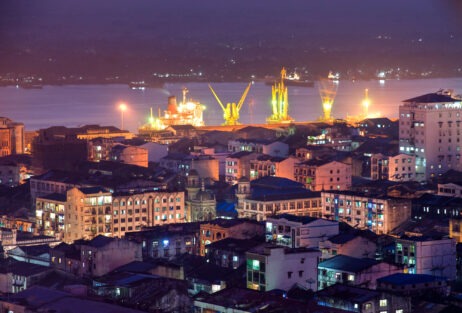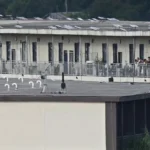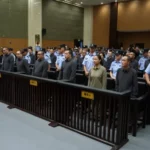
Myanmar’s Power Crisis: Energy Politics in the Dark
Myanmar has been gripped by severe electricity shortages since the 2021 military coup, intensifying the hardship faced by millions living under military rule. The power crisis began when foreign financing collapsed and currency instability worsened, driven by the political turmoil created by the coup. Liquefied natural gas (LNG) plants—including two major Chinese-backed facilities in Yangon—halted operations. The junta also cancelled 26 solar projects previously approved by the elected government.
As conflict escalated across the country, damage to transmission lines, power grids, and onshore oil fields further strained supply. Meanwhile, the regime prioritized electricity for military-controlled zones, leaving major cities like Yangon and Mandalay with as little as eight hours of power per day. Many other areas suffer even longer outages, and regions outside junta-held territory have been disconnected from the national grid entirely.
Attempts to resolve the crisis have stalled due to collapsing foreign investment, decaying infrastructure, political instability, and competing military interests. Over the past two years, the junta has also lost significant territory to ethnic armed organizations and People’s Defense Forces, especially following Operation 1027 in late 2023. Despite the worsening situation, the regime largely ignored the national energy sector until China increased pressure and extended political support in connection with the junta’s planned election. Since then, energy policy has become increasingly politicized and strategically driven.
Energy exports remain the backbone of the junta’s finances. The Myanma Oil and Gas Enterprise (MOGE) generates roughly half of the regime’s foreign currency income—over $2 billion annually. About 75 percent of offshore natural gas output is exported to China and Thailand, with only the remainder going to domestic consumption. These revenues are closely linked to the junta’s arms procurement and military operations, underscoring how energy resources help sustain its rule.
International energy companies such as Chevron, TotalEnergies, and Woodside exited Myanmar after the coup, citing political instability and human rights concerns. However, Thailand’s PTTEP, Gulf Petroleum Myanmar, China’s CNPC, and Korea’s POSCO International continue to operate in partnership with MOGE.
Facing dwindling resources, the regime has pushed for new natural gas exploration and oil refinery projects to secure much-needed foreign currency. Oil production has steadily declined, and outdated infrastructure has forced the junta to seek technology transfer and investments from China. In May 2024, MOGE signed the first offshore production-sharing contract since the coup with Gulf Petroleum Myanmar. Meanwhile, junta officials have repeatedly visited Russia and China to pursue cooperation in oil and gas exploration, including the use of artificial intelligence and GeoAudit technology from Russian state-owned firms.
The regime’s energy ambitions extend further. In February 2023, junta leader Min Aung Hlaing signed an agreement with Russia’s state nuclear corporation, Rosatom—an indicator of deeper diplomatic and technological alignment with Moscow. This move reflects political goals that reach far beyond immediate energy needs, even as Myanmar struggles to maintain basic electricity access.
In contrast, renewable energy development—critical for improving national electrification—has stalled. Solar tenders have been repeatedly delayed or reduced, and hydropower expansion remains uncertain due to environmental concerns and ongoing conflict. These projects require stable governance, investor confidence, and long-term contracts, all of which are undermined by the country’s political crisis and international sanctions. Despite rhetorical commitments to renewable energy, it remains peripheral to the junta’s true strategic priorities.
Ultimately, the junta’s energy policy appears focused on generating foreign currency, cementing political ties with Russia and China, and attempting to secure future investment following its planned election. While the regime benefits from billions in export revenue—funds linked to human rights violations and military suppression—ordinary Myanmar citizens receive none of the advantages. Instead, they endure worsening economic hardship and daily power outages, living with little hope of reliable electricity as the country descends deeper into darkness.
FAQs: Myanmar’s Power Crisis and Energy Politics
1. What caused Myanmar’s current electricity crisis?
Myanmar’s power crisis began after the 2021 coup, which triggered political instability, currency collapse, loss of foreign investment, and the shutdown of key LNG power plants. Ongoing conflict and damage to infrastructure have further worsened electricity shortages.
2. Why do major cities like Yangon and Mandalay still experience long blackouts?
Even major urban centers face up to 16 hours of outages because the regime prioritizes electricity for military-controlled zones. Limited domestic gas supply, damaged transmission lines, and declining energy investment also restrict power availability.
3. How does the junta generate income from the energy sector?
The Myanma Oil and Gas Enterprise (MOGE) provides roughly half of the junta’s foreign currency revenue—over $2 billion annually. Most offshore natural gas is exported to China and Thailand, generating significant income for the regime.
4. Which foreign companies continue to operate in Myanmar’s energy sector?
While major Western companies like Chevron, TotalEnergies, and Woodside have left, others remain, including Thailand’s PTTEP, Gulf Petroleum Myanmar, China’s CNPC, and Korea’s POSCO International. These firms operate in partnership with MOGE.
5. Why has renewable energy development stalled?
Renewable projects, especially solar and hydro, require stability, long-term contracts, and investor confidence. Political conflict, sanctions, and security risks have stalled tenders and weakened investor interest, leaving renewables sidelined.
6. How are energy revenues linked to human rights concerns?
Export revenues from oil and gas help fund the military’s operations, including arms procurement. Human rights groups have documented links between these funds and abuses committed by security forces.
7. What role do China and Russia play in Myanmar’s energy policy?
China remains a major importer of Myanmar’s gas and a key political supporter. Russia has expanded ties through nuclear cooperation and proposed technology-sharing for oil and gas exploration. Both relationships are driven by political and strategic alignment.
8. Is Myanmar likely to see improvements in electricity access soon?
Significant improvements are unlikely in the near term. Aging infrastructure, reduced foreign investment, ongoing conflict, and the regime’s political priorities limit the ability to restore stable power nationwide.
9. How has the coup affected foreign investment in energy?
The coup led to the withdrawal of major international companies due to sanctions, instability, and reputational risks. Remaining investors focus mainly on gas exports, not domestic electrification.
10. Who is most affected by the prolonged blackouts?
Ordinary citizens—especially those in rural and conflict-affected townships—face the worst conditions, with limited or no electricity access. Businesses, hospitals, schools, and households struggle daily to function amid widespread outages.
Related posts:
 SpaceX Cuts Starlink Access at Myanmar Scam Compounds
SpaceX Cuts Starlink Access at Myanmar Scam Compounds
 THE NATIONAL UNITY GOVERNMENT (NUG) OF MYANMAR
THE NATIONAL UNITY GOVERNMENT (NUG) OF MYANMAR
 PHUKET MARINE PARK ASSESSES CORAL IMPACT FROM SUNKEN MYANMAR SHIP.
PHUKET MARINE PARK ASSESSES CORAL IMPACT FROM SUNKEN MYANMAR SHIP.
 Myanmar Refugees in Thailand Face Uncertain Future as Aid Decreases
Myanmar Refugees in Thailand Face Uncertain Future as Aid Decreases
 China Executes 16 Tied to Myanmar Crime Syndicate
China Executes 16 Tied to Myanmar Crime Syndicate
 Dr. Sasa Resigns from NUG, Restructuring Expected Inside Shadow Government
Dr. Sasa Resigns from NUG, Restructuring Expected Inside Shadow Government
